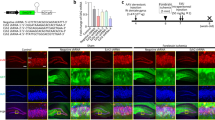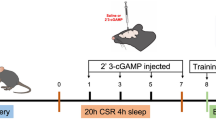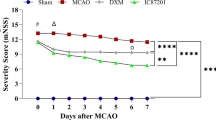Abstract
Sevoflurane, a commonly used anesthetic, has been found to cause neural stem cell (NSC) injury, thereby contributing to neurocognitive impairment following general anesthesia. Tetramethylpyrazine (TMP), one of the most widely used medicinal compounds isolated from a traditional Chinese herb, possess neuroprotective activity. However, its effect on sevoflurane-induced NSC injury remains unclear. NSCs were pretreated with indicated concentrations of TMP for 2 h and then exposed to sevoflurane for 6 h. Cell injury was measured using lactate dehydrogenase (LDH) release assay. Cell viability and proliferation were detected by cell counting kit-8 (CCK-8) assay and 5-bromo-2’-deoxyuridine (BrdU) labeling, respectively. Apoptotic cells were detected using terminal deoxynucleotidyl transferase dUTP nick end labeling (TUNEL) assay. The levels of cleaved caspase-3, phosphorylated protein kinase B (Akt) and phosphorylated glycogen synthase kinase-3β (GSK-3β) were detected by western blotting. Our results showed exposure to sevoflurane decreased the viability and proliferation of NSCs, while TMP preserved NSC viability and proliferation after sevoflurane exposure. In addition, the expression of cleaved caspase-3 and TUNEL positive cells were markedly decreased in TMP-treated NSCs compared with the control. Furthermore, pretreatment with TMP significantly increased the levels of phosphorylated Akt and GSK-3β in sevoflurane-injured NSCs. However, an upstream inhibitor of Akt, LY294002 abolished the protective of TMP on the cell viability of NSCs. In conclusion, these findings indicate that TMP protects NSCs from sevoflurane-induced toxicity through Akt/GSK-3β pathway.





Similar content being viewed by others
Data availability statement
The data that support the findings of this study are available from the corresponding author upon reasonable request.
References
Brown EN, Pavone KJ, Naranjo M (2018) Multimodal General Anesthesia: Theory and Practice. Anesth Analgesia 127:1246–1258
Chen JM, Wang HQ, Gao CJ, Liu D, Fan YW, Li WJ, Chen YZ, Pan SM (2019) Tetramethylpyrazine alleviates LPS-induced inflammatory injury in HUVECs by inhibiting Rho/ROCK pathway. Biochem Biophys Res Commun 18:329–335
Chen HY, Cao J, Zhu ZY, Zhang GX, Shan LC, Yu P, Wang YQ, Sun YW, Zhang ZJ (2018) A novel tetramethylpyrazine derivative protects against glutamate-induced cytotoxicity through PGC1α/Nrf2 and PI3K/Akt signaling pathways. Front Neurosci 12:567–579
Chen Z, Pan X, Georgakilas AG, Chen P (2013b) Tetramethylpyrazine (TMP) protects cerebral neurocytes and inhibits glioma by down regulating chemokine receptor CXCR4 expression. Cancer Lett 336:281–289
Dulken BW, Leeman DS, Boutet SC, Hebestreit K, Brunet A (2017) Single-Cell Transcriptomic Analysis Defines Heterogeneity and Transcriptional Dynamics in the Adult Neural Stem Cell Lineage. Cell Rep 18:777–790
Fan Y, Wu Y (2017) Tetramethylpyrazine alleviates neural apoptosis in injured spinal cord via the downregulation of miR-214-3p. Biomed Pharmacother 94:827–833
Guo M, Liu Y, Shi DZ (2016) Cardiovascular Actions and Therapeutic Potential of Tetramethylpyrazine (Active Component Isolated from Rhizoma Chuanxiong): Roles and Mechanisms. BioMed Res Int. 2016: 2430329–2430337
Harms AS, Tansey MG (2013) Isolation of Murine Postnatal Brain Microglia for Phenotypic Characterization Using Magnetic Cell Separation Technology. Methods Mol Biol 1041:33–39
Jafari M, Ghadami E, Dadkhah T, Akhavan-Niaki H (2019) PI3K/AKT signaling pathway: erythropoiesis and beyond. J Cell Physiol 234:2373–2385
Jope RS, Yuskaitis CJ, Beurel E (2007) Glycogen synthase kinase-3 (GSK3): Inflammation, diseases, and therapeutics. Neurochem Res 32:577–595
Kang Y, Hu M, Zhu Y, Gao X, Wang MW (2009) Antioxidative effect of the herbal remedy Qin Huo Yi Hao and its active component tetramethylpyrazine on high glucose-treated endothelial cells. Life Sci 84:428–436
Keishi K, Hideki H, Miho A, Maiko O, Yuan B, Norio T (2018) Possible Involvement of PI3-K/Akt-Dependent GSK-3β Signaling in Proliferation of Neural Progenitor Cells After Hypoxic Exposure. Mol Neurobiol. 1–11
Kim M, Kim SO, Lee M, Lee JH, Lee EH (2014) Tetramethylpyrazine, a natural alkaloid, attenuates pro-inflammatory mediators induced by amyloid β and interferon-γ in rat brain microglia. Eur J Pharmacol 740:504–511
Kim SU (2010) Human neural stem cells genetically modified for brain repair in neurological disorders. Neuropathology 24:159–171
Lee BH, Chan JT, Obhi H, Laszlo V, Sall JW, Yael AV (2014) Early Exposure to Volatile Anesthetics Impairs Long-Term Associative Learning and Recognition Memory. PLOS ONE 9:e105340
Lei G, Xia Y, Johnson KM (2008) The role of Akt-GSK-3beta signaling and synaptic strength in phencyclidine-induced neurodegeneration. Neuropsychopharmacology 33:1343–1353
Li SY, Jia YH, Sun WG, Tang Y, An GS, Ni JH, Jia HT (2010) Stabilization of mitochondrial function by tetramethylpyrazine protects against kainate-induced oxidative lesions in the rat hippocampus. Free Radical Biol Med 48:597–608
Liang Y, Yang QH, Yu XD, Jiang DM (2011) Additive effect of tetramethylpyrazine and deferoxamine in the treatment of spinal cord injury caused by aortic cross-clamping in rats. Spinal Cord 49:302–306
Ling Y, Li X, Yu L, Liang QS (2017a) Sevoflurane exposure in postnatal rats induced longterm cognitive impairment through upregulating caspase3/cleavedpoly (ADPribose) polymerase pathway. Exp Ther Med 14:3824–3830
Michel HE, Tadros MG, Esmat A, Khalifa AE, Abdel-Tawab AM (2016) Tetramethylpyrazine Ameliorates Rotenone-Induced Parkinson’s Disease in Rats: Involvement of Its Anti-Inflammatory and Anti-Apoptotic Actions. Mol Neurobiol 54:1–13
Nie H, Peng Z, Lao N, Dong H, Xiong L (2013) Effects of Sevoflurane on Self-Renewal Capacity and Differentiation of Cultured Neural Stem Cells. Neurochem Res 38:1758–1767
Pang P, Shan J, Chiu K (1996) Tetramethylpyrazine, a calcium antagonist. Planta Med 62:431–435
Presečki P, Mihanović, Mimica M, Ninoslav (2010) Cognitive impairment and general anaesthesia - Case report. Psychiatr Danub 22:385–386
Qiu J, Shi P, Mao W, Zhao Y, Liu W, Wang Y (2015) Effect of apoptosis in neural stem cells treated with sevoflurane. BMC Anesthesiol 15:1–8
Ramage TM, Chang FL, Shih J, Alvi RS (2013a) Distinct long-term neurocognitive outcomes after equipotent sevoflurane or isoflurane anaesthesia in immature rats. Brit J Anaesthesia 110:39–46
Sabelstrm H, Stenudd M, Frisén J (2014) Neural stem cells in the adult spinal cord. Exp Neurol 260:44–49
Sall JW, Stratmann G, Leong J, Mckleroy W, Bickler PE (2009) Isoflurane inhibits growth but does not cause cell death in hippocampal neural precursor cells grown in culture. Anesthesiology 110:826–833
Singh S, Mishra A, Bharti S, Tiwari V, Singh J, Parul, Shukla S (2018) Glycogen synthase kinase-3β regulates equilibrium Between Neurogenesis and Gliogenesis in Rat Model of Parkinson’s Disease: a Crosstalk with Wnt and Notch Signaling. Mol Neurobiol 55:6500–6517
Sprung J, Roberts RO, Knopman DS, Price LL, Schulz HP, Tatsuyama CL, Weingarten TN, Schroeder DR, Hanson AC, Petersen RC (2017) Mild Cognitive Impairment and Exposure to General Anesthesia for Surgeries and Procedures: A Population-Based Case Control Study. Anesth Analg 61:1277–1290
Stenudd M, Sabelstr M, Frisén H, J (2015) Role of Endogenous Neural Stem Cells in Spinal Cord Injury and Repair. Jama Neurol 72:235–237
Tian Y, Liu Y, Chen X, Zhang H, Shi Q, Zhang J, Yang P (2010) Tetramethylpyrazine promotes proliferation and differentiation of neural stem cells from rat brain in hypoxic condition via mitogen-activated protein kinases pathway in vitro. Neurosci Lett 474:26–31
Tian Y, Guo S, Wu X, Ma L, Zhao X (2015) Minocycline Alleviates Sevoflurane-Induced Cognitive Impairment in Aged Rats. Cell Mol Neurobiol 35:585–594
Tiwari SK, Seth B, Agarwal S, Yadav A, Karmakar M, Gupta SK, Choubey V, Sharma A, Chaturvedi RK (2015) Ethosuximide Induces Hippocampal Neurogenesis and Reverses Cognitive Deficits in an Amyloid-β Toxin-induced Alzheimer Rat Model via the Phosphatidylinositol 3-Kinase (PI3K)/Akt/Wnt/β-Catenin Pathway. J Biol Chem 290:28540–28558
Wang C, Lu CF, Peng J, Hu CD, Wang Y (2017b) Roles of neural stem cells in the repair of peripheral nerve injury. Neural Regen Res 12:2106–2112
Wang N, Lu Y, Wang K, Li WS, Lu P, Lei S, Li R, Zhang H, Zheng J, Lu HX (2018) Simvastatin Attenuates Neurogenetic Damage and Improves Neurocongnitive Deficits Induced by Isoflurane in Neonatal Rats. Cell Physiol Biochem. 618–632
Wang S, Lei T, Zhang M, Ferenc G (2016) The Reversal Effect and Its Mechanisms of Tetramethylpyrazine on Multidrug Resistance in Human Bladder Cancer. PLOS ONE 11:e0157759
Wu X, Zhang F, Xiong X, Lu C, Lian N, Lu Y, Zheng S (2015) Tetramethylpyrazine reduces inflammation in liver fibrosis and inhibits inflammatory cytokine expression in hepatic stellate cells by modulating NLRP3 inflammasome pathway. IUBMB Life. 67
Xiao X, Liu Y, Qi C, Qiu F, Chen X, Zhang J, Yang P (2010) Neuroprotection and enhanced neurogenesis by tetramethylpyrazine in adult rat brain after focal ischemia. Neurol Res 32:547–555
Xie M, Shi R, Pan Y, Zeng T, Chen Q, Wang S, Liao X (2014) Proteasome Inhibition-Induced Downregulation of Akt/GSK-3β Pathway Contributes to Abnormality of Tau in Hippocampal Slice. Mol Neurobiol 50:888–895
Xie Z, Xu Z, Yue Y, Busscher JJ, Wang H, Shie V, Zheng H, Dong Y, Zhang Y (2013) Sevoflurane Inhibits Neurogenesis and the Wnt-Catenin Signaling Pathway in Mouse Neural Progenitor Cells. Curr Mol Med 13:1446–1454
Yang WT, Zheng XW, Chen S, Shan CS, Xu QQ, Zhu JZ, Bao XY, Lin Y, Zheng GQ, Wang Y (2017) Chinese herbal medicine for Alzheimer’s disease: Clinical evidence and possible mechanism of neurogenesis. Biochem Pharmacol. S0006295217304793
Yang Q, Huang DD, Li DG, Chen B (2019) Tetramethylpyrazine exerts a protective effect against injury from acute myocardial ischemia by regulating the PI3K/Akt/GSK-3β signaling pathway. Cell Mol Biol Lett 24:17–28
Yasuda N, Lockhart SH, Eger EI, Weiskopf RB, Peterson NA (1991) Comparison of kinetics of sevoflurane and isoflurane in humans. Anesth Analgesia 72:316–324
Yy A, Yw A, Liang KA, Yc B, Jy A (2019) Osthole decreases tau protein phosphorylation via PI3K/AKT/GSK-3β signaling pathway in Alzheimer’s disease. Life Sci 217:16–24
Zhang R, Zhang Z, Chopp M (2016) Function of neural stem cells in ischemic brain repair processes. J Cerebr Blood F Met 36:2034–2043
Zhao J, Han J, Jiang J, Shi S, Ma X, Liu X, Wang C, Nie X, He Y, Jiang S, Wan C (2015) The downregulation of Wnt/β-catenin signaling pathway is associated with zinc deficiency-induced proliferative deficit of C17.2 neural stem cells. Brain Res 1615:61–70
Zhao S, Zhang Z, Zhen Y, Shao J, Chen A, Feng Z, Zheng S (2017) Tetramethylpyrazine attenuates sinusoidal angiogenesis via inhibition of hedgehog signaling in liver fibrosis. IUBMB Life. 69–127
Zhao Y, Yue L, Chen K (2016) Mechanisms and Clinical Application of Tetramethylpyrazine (an Interesting Natural Compound Isolated from Ligusticum Wallichii): Current Status and Perspective. Oxid Med Cell Longev. 2016: 2124638–2124646
Zheng R, Zhang ZH, Chen C, Chen Y, Jia SZ, Liu Q, Ni JZ, Song GL (2017) Selenomethionine promoted hippocampal neurogenesis via the PI3K-Akt-GSK3β-Wnt pathway in a mouse model of Alzheimer’s disease. Bioche Biophys Res Commun 485:6–15
Zhou X, Lu D, Li WD, Chen XH, Yang XY, Chen X, Zhou ZB, Ye JH, Feng X (2017) Sevoflurane Affects Oxidative Stress and Alters Apoptosis Status in Children and Cultured Neural Stem Cells. Neurotox Res 33:790–800
Acknowledgements
The authors thank Dr Haidong Wei for his help in revising the manuscript.
Funding
This study was supported by the National Key Research and Development Program of China (2019YFE0115300), National Natural Science Foundation of China (82071482), the Science and Technology Program Fund of Xi’an (2017115SF/YX009), and the Xi’an People’s Hospital (Xi’an Fourth Hospital) Research Incubation Fund (ZD-2) in China.
Author information
Authors and Affiliations
Contributions
Pengbo Zhang and Kui Wang designed this study. Yan Feng and Ning Wang performed experiments. Pengyu Jia and Lei Zhang collected the data. Haozheng Yuan and Pan Lu analyzed the data. Yang Lu and Hong Zhang wrote this paper. Rong Li and Yan Zhang contributed the methodology. Qianqian Li operated the software.
Corresponding author
Ethics declarations
Conflict of interest
The authors declare that they have no conflict of interest.
Statement of ethics
Not applicable.
Additional information
Publisher’s note
Springer Nature remains neutral with regard to jurisdictional claims in published maps and institutional affiliations.
Rights and permissions
About this article
Cite this article
Feng, Y., Wang, K., Wang, N. et al. Tetramethylpyrazine protects neural stem cells against sevoflurane-induced toxicity through Akt/GSK-3β pathway. Metab Brain Dis 37, 2457–2466 (2022). https://doi.org/10.1007/s11011-022-01008-2
Received:
Accepted:
Published:
Issue Date:
DOI: https://doi.org/10.1007/s11011-022-01008-2




